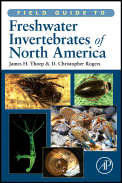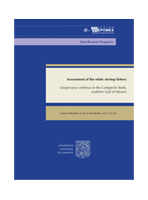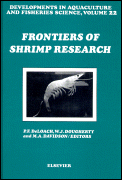
| Inicio |
| Objetivos |
| Noticias |
| Biblioteca virtual |
| Participantes |
| Otros |

Centro EPOMEX,
Universidad Autónoma
de Campeche
Tel (52) (981) 81-19800
ext 62300
Fax (52) (981) 81-19800
ext 62399
Responsable
del proyecto:
| Biblioteca virtual | |||
Libro
Shrimps are subject to great consumer demand in the United States. However, more than #1 billion worth of shrimp is now imported; more than twice the amount produced domestically. Domestic shrimp production, mostly from the trawler fleet in the Gulf of Mexico, is thought to be at its maximum sustainable yield of 91,000 MT (heads-off). Increased production of shrimp in the U.S. through mariculture has been motivated by the increasing demand for this product. The biology of penaeid shrimp and lack of technology for their culture present special problems in fisheries science, reproductive biology, endocrinology, nutrition, pathology, culture science and future research. The purpose of the Frontiers of Shrimp Research symposium was to assess the status of shrimp research in these areas and to further foster the scientific collaboration vital for significant research advances. The participants included representatives of the science funding agencies, the mariculture industry and representatives of both the scientific research and science policy communities. The subject matter should be of interest to a variety of readers. Advanced undergraduate/graduate students, mariculturists and research workers will find this volume both interesting and informative. Eugene H. Buck Sea turtles, almost all species of which have been declared threatened or endangered, can be inadvertently caught and drowned in trawl nets pulled by fishing vessels harvesting shrimp. The United States has reduced sea turtle mortality by requiring U.S. shrimp trawlers to use turtle excluder devices (TEDs) to reduce turtle drownings; however, turtle mortalities from some foreign shrimp vessels might still be substantial. The use of TEDs reduces the efficiency of shrimp trawling; some domestic shrimpers contend the economic impacts are severe. Efforts to reduce finfish bycatch during shrimp trawling could result in additional restrictions or regulations on shrimp harvesters.
|
Revistas
L.G. Abarca-Arenas, J. Franco-Lopez, M.S. Petersonc, N.J. Brown-Peterson and E. Valero-Pacheco
Continental shelf macrofauna are impacted by trawling and associated by-catch activities. These activities have been predicted to change the macrofaunal community structure and the resulting food web. Four food webs (three seasonal and one pooled) were constructed using shrimp by-catch samples from 21 surveys from 1991 to 1994. Network sociometric analyses were performed on the webs in order to explore structural characteristics focusing on the role of penaeids. The number of nodes varied from 43 to 73. The out-degree centrality value for the combined web was the highest. For the penaeid node, the windy season centrality was the highest (47%) and the rainy season the lowest (11%). The number of cutpoints by season was: windy four, dry two, and three for the combined web. Using the lambda sets analysis; penaeid is a key node for the structural cohesion of the trophic network. The rainy season food web is the most homogeneous and penaeid is an important node such that its elimination would cause a major structural and functional disruption to the network. These modeling exercises suggest over-fishing by trawlers would impact the continental shelf community structure and thus significantly change the existing trophic relationships.
![]()
Silvia Salasa, Ratana Chuenpagdeeb, Juan Carlos Seijoc and Anthony Charlesd
This paper presents an overview of the key characteristics of small-scale coastal marine fisheries in Latin America and the Caribbean as well as an examination of some of the weaknesses, gaps, and challenges faced in fisheries assessment and management within the region. The information here is based largely on discussions involving a range of scientists, managers and fishers at the first CoastFish conference (“Coastal fisheries in Latin America and the Caribbean”) held in Merida, Mexico in 2004 and literature review. Small-scale fisheries in this region, as elsewhere, share similar characteristics including multi-gear and multispecies, low capital and labour intensive, remote landing sites, large number of migrant and seasonal workers, and weak market and bargaining power among fishers. Common issues facing these fisheries are resource overexploitation, complex and dynamic fleet interactions, competition and conflicts between fleets (small-scale, industrial and recreational), and post-harvest problems, such as lack of infrastructure. Research in the region focuses mainly on biological–ecological aspects, with limited attention paid to socio-economic issues. Collection of catch data is common in most countries, at least for the main target species, but its reliability has been questioned in many cases, especially when a multi-species fishery is in place. Management tools frequently used are ‘input control’, e.g., size limit, gear restriction, closed season, closed area, and fishing permits. Finally, legal frameworks typically exist to regulate fisheries in most countries, but lack of success in management could be attributed to a lack of surveillance, weak institutions, unclear legal management instruments, and limited involvement of fishers in the management process. Based on the above, we discuss ways to address gaps and challenges in the assessment and management of small-scale fisheries in Latin America and the Caribbean.
![]()
Bisessar Chakalalla, Robin Mahonb, Patrick McConneyb, Leonard Nurseb and Derrick Odersonc
Living marine resources are critical for human well-being in the Wider Caribbean region. These are mainly fisheries resources which provide food and employment for many thousands of coastal inhabitants. Other non-exploited resources such as reef corals are also important in sustaining tourism. Many of these resources are transboundary and require collaboration for effective governance. The fact that many of the fisheries are small-scale makes this even more difficult. In this paper we address the governance needs for marine systems in the Wider Caribbean region through the evaluation of Institutional arrangements for governance (IAG) of transboundary marine resources. We observe that IAG in the region are weak or lacking, and issues of scale are the most challenging ones for this region given the range in size, development and capacity of the countries in the area. Existing organisations will need to be adapted for governance having been designed for other primary purposes. For instance, fisheries organisations are most well established but lack decision-making functions. There are no large fishery stocks from which to derive revenues to support a regional fisheries management organisation. Improved institutions must be tailored to Caribbean reality. Alternative models must be considered and evaluated with concerns such as cost, equitability and best use of expertise in mind. This paper is not prescriptive but outlines options and approaches for adequate regional governance of fisheries, including some pros and cons. There will be the need for a considerable amount of developmental work before feasible mechanisms can be proposed.


